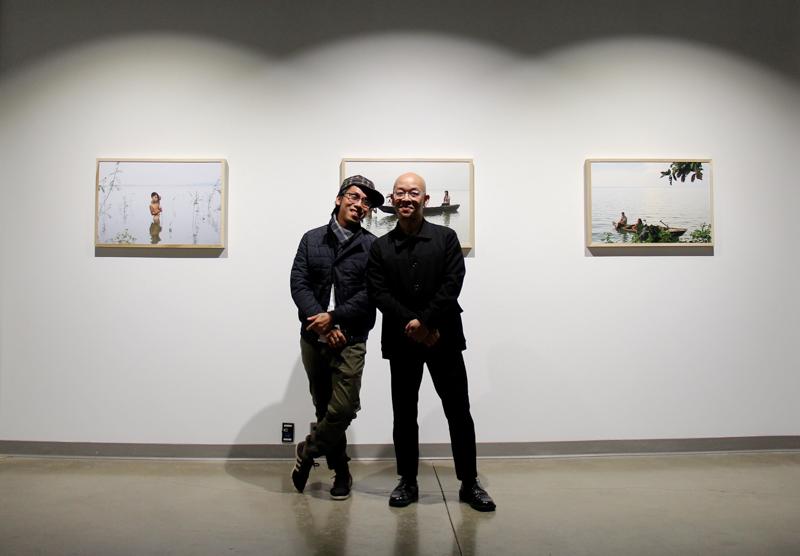Nguyen Blurs Line Between Candid and Staged
Photo by Clover Linh Tran, Staff photographer
Oberlin’s Artist in Residence for February, Duy Phuong Le Nguyen (left) and Art Department Co-chair Pipo Nguyen-Duy pose in front of Nguyen’s photos in the Richard D. Baron ‘64 Art Gallery. The exhibit, Holding Water, depicts Tri An Lake in Vietnam.
February 19, 2016
Holding Water, the current exhibit at the Richard D. Baron ‘64 Art Gallery, is deceptively simple at first glance. Unlike many art shows. in which each piece is accompanied by a title and a short paragraph with contextual details, the photographs by Duy Phuong Le Nguyen — Oberlin’s artist in residence for the month of February — stand alone. For his first solo show, the artist has chosen to let his work speak for itself.
Without any information provided on the photographs’ subjects or locations, each image is all the more captivating. As the exhibit’s title would suggest, its unifying theme is water. Water is, however, much more than just a backdrop to the people in the photographs. Nguyen’s photographs present water with an unusual degree of depth and variation, making it almost a character in its own right rather than a backdrop. The water is never tangential to the human story being hinted at. One image juxtaposes a child in an orange balloon hat against a landscape of blue, the background stretching so far behind him that the line between lake and horizon is blurred. Another depicts a person washing clothes in shallow water, surrounded by foliage on all sides. Many of the photographs are of children, some who sit and stare seriously into the camera, some who float on their backs in the water and others who play, seemingly ignorant of the photographer’s presence. Although many of the images convey a sense of vastness and distance, there is also intimacy in the moments captured here.
A short distance away from the hub of campus life, the gallery seems like the perfect setting for these photographs. The deep blues and greens in the images stand out against the unvarnished wooden frames and white walls on which they are mounted. The images are not crowded on the gallery’s walls, but spread in a way that almost forces a visitor to devote their entire attention to one photograph before turning their attention to the next. In this arrangement, the images seem like windows to another time and place. In such a silent space, it almost seems possible to hear the ripples of lake water on the shore.
Taken over a five-year period, Nguyen’s photographs follow the lives of the people who live around Tri An Lake in the artist’s native Vietnam. Although almost all of the photographs focus on human bodies interacting with water — often via boats — one aspect of Tri An Lake is strikingly absent. This lake is home to one of the largest hydroelectric dams in South Vietnam for which the lake is best known. The relationship between human and water in terms of hydroelectricity could have been the dominant narrative of this exhibit, but instead, the artist takes a very different route.
On his website, the artist describes his style as “[a combination of] documentary approach and staging.” This adds a dimension of mystery to the exhibit; it is not always clear whether an image was contrived or whether the captured moment would have happened regardless of the photographer’s presence. A viewer who is willing to suspend their disbelief and accept the images simply as they see them is treated to the artist’s interpretation of life around Tri An Lake over time. While it is possible to treat this exhibit as a puzzle to be solved in terms of classifying the images — some of which may have elements that are both documentary and staged within one photograph — there is real enjoyment to be gained by taking it as a testament to something the artist wanted people to understand, no more and no less.
The title of the exhibit, Holding Water, seems apt. Aside from its literal meaning, the title can also be read as a challenge to see whether this combination of images “holds water” in presenting a cohesive picture of Tri An Lake and the people who live around it. The exhibit poses a challenge to viewers and meets this self-imposed challenge easily.


























